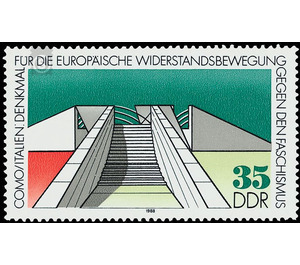Commemorative stamp series - Germany / German Democratic Republic 1988 - 35 Pfennig
Theme: Architecture
| Country | Germany / German Democratic Republic |
| Issue Date | 1988 |
| Face Value | 35.00 |
| Color | green |
| Perforation | K 14 |
| Printing Type | Rotogravure 2 |
| Stamp Type | Postage stamp |
| Item Type | Stamp |
| Chronological Issue Number | 2938 |
| Chronological Chapter | GER-DDR |
| SID | 711975 |
| In 18 Wishlists | |
Memorial to the European resistance movement against fascism in Como (Italy) The Ministry of Posts and Telecommunications of the German Democratic Republic issues a multicolored special postage stamp with a picture of the monument for the European resistance movement against fascism in Como (Italy). Special stamp from 13th September to 12th November 1988 Monument to the European resistance movement against fascism in Como (Italy) On the edge of a park, leading directly to Lake Como, a monument has been attracting inhabitants and guests of the northern Italian city of Como for five years Thinking about. The impressively designed monument for the European resistance movement against fascism was inaugurated on 28 May 1983 in the presence of President Sandro Pertini and anti-fascist resistance fighters from more than 15 European countries. Also present was Arialdo Banfi, longtime president of the International Federation of Resistance Fighters (FIR), who himself had fought against fascism at Como. The wooded mountain country near Lake Como was a gathering point and activity area of Italian partisans in 1944/45. With its collection on April 25, 1945 in Milan about 40 kilometers away began the final liberation of Italy. The initiative to design a monument to the European resistance movement against fascism was initiated by local partisan associations. The concept was realized after a long discussion by an authorized body. The creator of the monument is the sculptor and ceramist Gianni Colombo, born in Milan in 1937, whose works include: a. in galleries and museums in Italy and Austria, in Switzerland and England as well as in North and South America. The monument in Como is intended to keep alive the idea of European resistance to fascism. In a simple design, three stone ramps converge in a star shape without them meeting. Each of these ramps in individual form and rhythm lead to the center of the monument complex. Here are on three large, slanted bronze plates in Russian, German, French, Italian and other languages immortalized last words of murdered anti-fascists. By Elli Voigt, member of the Berlin Resistance Group Saefkow-Jacob-Bästlein, who was executed on the scaffold in Plötzensee on December 8, 1944: "In the hope of life I go to my death, I walk in the belief in a better life for all of you." By Julius Fucik: "Humans, I loved you, always be vigilant!" 18 final words - 18 calls to life! Between the two star-points towards the lakeshore there is a stele made of crystal glass with edges of light natural stone. The stones come from eleven fascist extermination camps, including Auschwitz, Dachau, Mauthausen, Theresienstadt, Buchenwald, Sachsenhausen and Ravensbrück. A special place in the monument complex is a fragment of Hiroshima - a radioactively blackened stone. May the monument to the European resistance movement against fascism in its overall design be a meeting place, which gives reason to think about the resistance and our present time - so Gionni Colombo in a foreword.


